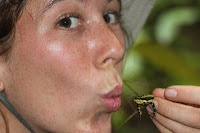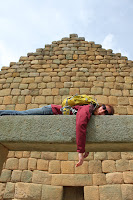


Having completed everything that we needed to do in Quito by around 2:00 on Monday afternoon, we decided that there was no reason to hang around here for the entire week. Since neither one of us has yet been to the Ecuadorian coast, we decided to make a trip to the beach our final adventure for this year. Having been recommended by Giovanni and his Italian friend, Italo, to go to Pedernales, we decided to go somewhere quite close. We love our Rough Guide dearly for all that it has done for us, and it delivered this time as well. I called the number for a secluded beachfront hotel, and we had our reservation without any trouble. But, as you know by now, this is Ecuador.
Due to its incredible traffic congestion which has developed over the past 15 years or so, Quito recently enacted a transportation law with the aim of improving traffic flow. As it stands, they use the final digit of a car’s license plate to enforce the law. Each day of the week, there are two final digits which are forbidden to be on the road between 7-9:30 AM and 4-7:30 PM. Tuesday happens to be 3 and 4, and it also happens to be the day when we were making our merry way to the coast for a relaxing trip. We had breakfast at the usual hour of 7 AM, and we were in the car by 7:30. We had made it across the city and nearly to the highway when we attracted the attention of a motorcycle policeman. He motioned for us to pull over, so we did. I handed him my driver’s license, and he proceeded to inform us that our car was not allowed to be on the road at that time of day (he took the liberty of adding an extra hour to the stated time during his explanation). He then mentioned that our car would be impounded and that we would have to pay $80 to get it back the next day.
Being a generally polite person, I offered to wait until 9:30 in order to respect their law before resuming our journey. He didn’t go for that, and he told us to follow him to where a group of other officers was on patrol. They had us pull into a bus company’s parking lot, and we were hoping that we would get to wait there. A few minutes later, however, one of the officers came over and told me that I needed to walk down the street and talk to a different officer about our situation. So, I walked over and began a nice friendly conversation with this officer. He repeated the law and the prescribed punishment to me several times, of course while managing to ask where I’m from, what I think of President Obama, and other things. When I expressed my distaste for having my car impounded, he pulled out his cell phone and called the guy who pulled us over to see if he would be willing to “help us out.” After a bit of beating around the bush, it came to the point that we would be allowed to drive away at 9:30 after all.
Now, I need to point out that I am new with the whole bribing police officers and government officials thing. I attempted to make a deal with this officer right there on the street since he seemed to be in charge of the operation. As soon as I reached for my wallet, however, he stepped back with his hands up. He then decided to have me go back to our car and wait for the officer who pulled us over. Once this guy showed up, I attempted to pull out my wallet again. Being the well-trained sleazeballs that they are, he told me to get in the car and then pull out the money. He handed me my driver’s license back, and I handed him his $60 bribe. Lovely. Then the guy in charge of the bus station demanded $5 for us to park there for an hour and a half (which was about three times overpriced), but I figured I wasn’t really in a position to make anyone mad at us. We read our books until 9:30, and then we got back on the road to the beach.
Once we got on the road (and out of Quito) the drive itself was quite nice. First we had to drive down the western slopes of the Andes to the coast. The road is thin, trafficky, and winds through the mountains. The mountainsides are lushly green, at times foggy, and the waterfalls are spectacular. Road crews are working diligently to meet the demands of increased traffic, but widening a road through the mountains can’t be an easy job. Once we got through the mountains and past Santo Domingo, the road flattens out on the coastal plains. We stopped for a quick lunch, and continued another couple of hours to the coast. Pedernales is the closes beach to Quito, and the hotel we had made a reservation at, Punta Prieta, was just south of Pedernales.
We arrived to the hotel, and had to pull the car through two gates before reaching the reception desk. The woman at the desk said she had no information about the reservation we had made only a day earlier, and wasn’t too friendly about it. We asked to see the rooms, and she readily agreed—starting with the most expensive. Well, the most expensive was out of our price range, and we nearly had to beg to see the cheap room. After some deliberation, she decided the cheap room wasn’t going to suit our needs and she gave us the mid-range room for the cheap price $30/ night. The room itself had two full sized beds, a bathroom with hot water, and a beautiful balcony with a small table and two hammocks. The room was built at the top of a cliff, facing the beach south of the point. It was private, serene, and a perfect place for us to relax a bit before coming home.
After making our lodging arrangements, we headed down for a late afternoon walk on the beach before dinner. The weather was cool, cloudy, and a bit windy. We took off our shoes and waded in the water. We appreciated the smell of the ocean breeze, the wildlife, and the colorful seashells.
We returned to our room before dark, got cleaned up, and walked over to the hotel’s restaurant for our 7:30 reservation. The hotel is quite secluded, so the restaurant there was really our only dining choice; we were not disappointed. The same woman who had shown us the rooms prepared our dinner, and was quite apologetic that they didn’t have fish because they weren’t expecting us—would shrimp be alright? So we sat alone in the restaurant, tauted in our Rough Guide for it’s spectacular views, and enjoyed a simple dinner of shrimp, rice, and vegetables. We didn’t find out until the next day just how spectacular the cliff top views were, complete with pelicans and other birds flying by and iguanas hanging out in the brush beneath the window.
The weather insisted on being cool and cloudy the next day, so we enjoyed walking on the beach, sitting in the hammocks and reading our books. The hotel staff had also set up two hammocks in a little cabana on the beach for us, so we had our choice of locations on the private beach and our skin was sheltered from the harsh sun. The day was broken up by our meals, shrimp ceviche for lunch and pan fried fish for dinner. We went to bed early, and fell asleep to the waves crashing onshore.
We had another half day to spend on the beach, collected a few more seashells and took a walk down the south beach toward a group of fishing boats. We left the hotel before lunch and drove to Pedernales to check out the coastal scene there. While we ate encocados (fish cooked in coconut milk) at a restaurant across the street from the beach, we saw that Pedernales was a slightly more “hopping” place. There were chairs and boogie boards for rent on the beach, juices and alcohol for sale in little thatched stands, and vendors selling an array of tourist souvenirs. I think we made the right choice with our secluded cliff top hotel.
We spent the afternoon driving back to Quito, and got here just in time to miss dinner. Giovanni kindly offered to make us a soup, and although I wasn’t hungry I knew Brad wouldn’t decline the offer. It was a quiet evening, and a nice opportunity to chat with Giovanni over bowls of potato, spinach, and cheese soup. He reminded us that breakfast would be served promptly at 7:00 am, then wished us a good night. Later, we made some phone calls to family and enjoyed our last full night of sleep before returning to the US.
This is our last blog until February 2011, we hope you’ve enjoyed them and promise to continue just as soon as we return to Ecuador! Our lives in the US just aren’t quite so interesting…














































